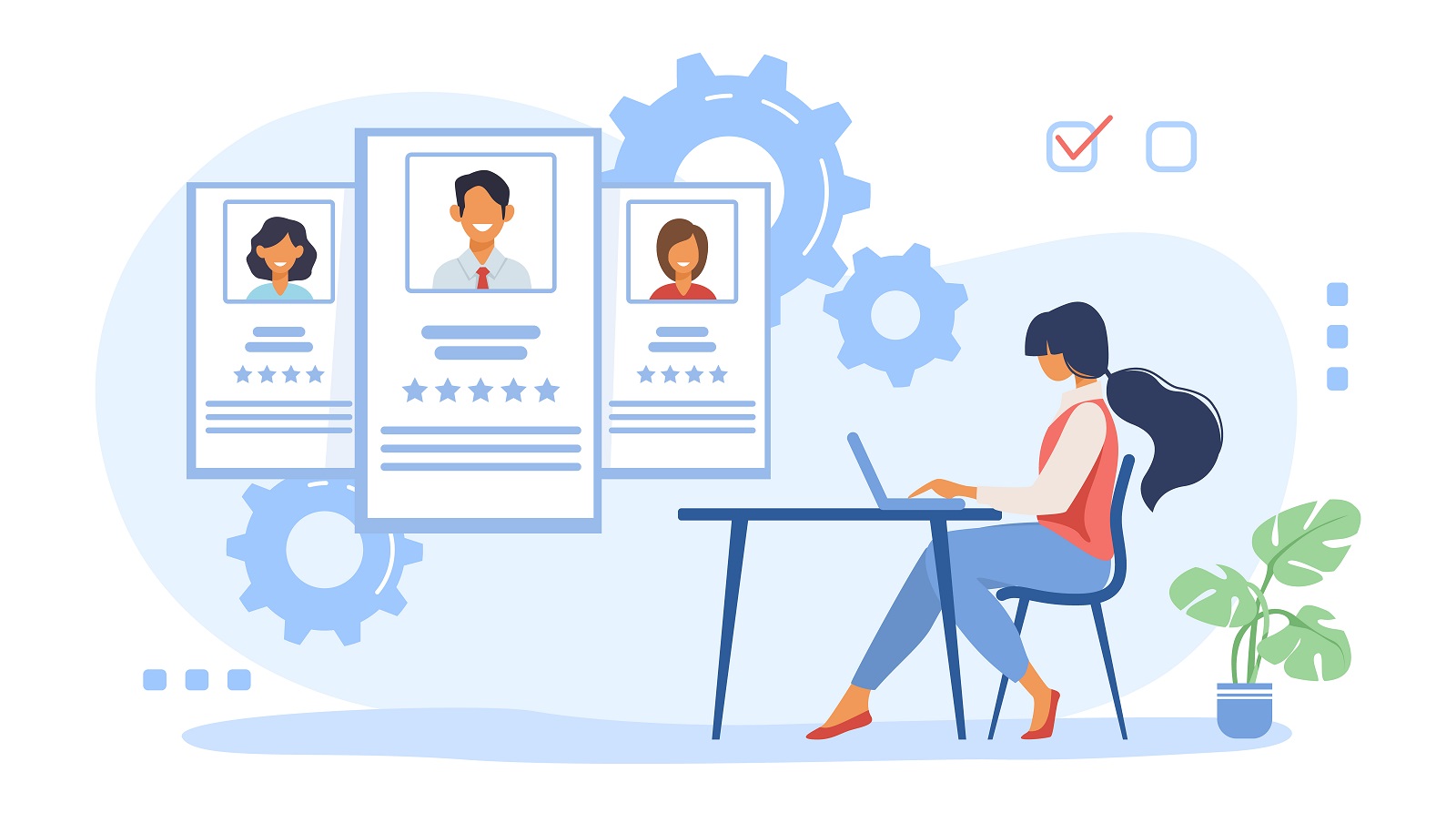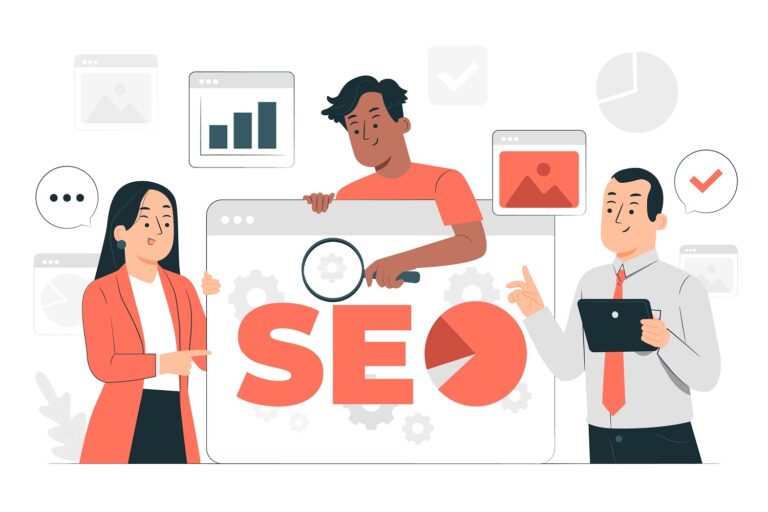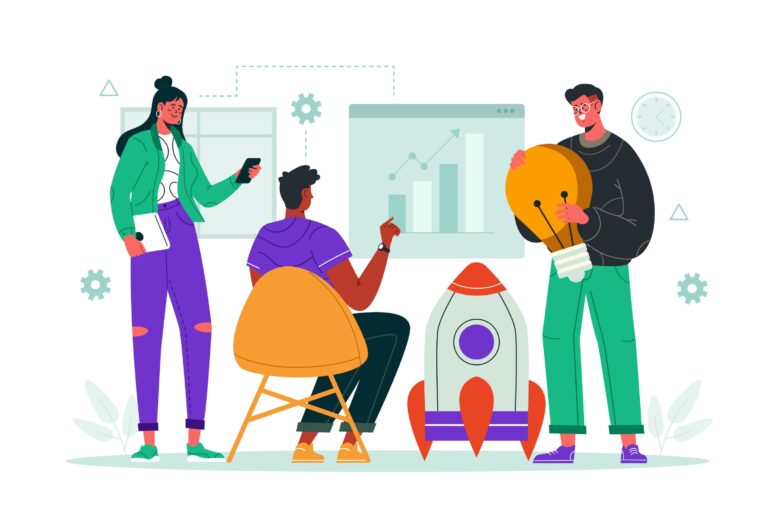Unleashing the Power of AI in HR: From Recruitment to Employee Engagement
Dive into this thrilling journey that uncovers how AI is shaking up the world of HR! From supercharging recruitment to reinventing employee engagement, this article sheds light on the exciting fusion of technology and talent management. Prepare to grapple with emerging ethical dilemmas and peek into the future of AI-driven HR. Expect to be surprised, informed, and inspired!
I. Introduction
A. Brief Overview of AI in Human Resources
Artificial Intelligence has permeated nearly every industry, revolutionizing operations, decision-making processes, and customer experiences. Yet, its integration into the Human Resources field stands as one of the most transformative applications of this technology. From the traditional role of managing employee relations and ensuring regulatory compliance, HR has now evolved into a strategic business unit. It’s an integral part of fostering an engaged workforce, acquiring top talent, and promoting a company culture that aligns with the organization’s vision.
AI in HR might seem futuristic, but it’s already a reality in many organizations. From chatbots answering employee queries in real-time to predictive analytics enhancing talent acquisition, AI is redefining HR functions. By automating repetitive tasks, AI allows HR professionals to focus on strategic issues that require human insights and judgments, such as building a strong corporate culture or creating an inclusive workplace. The use of AI also ensures more accurate and data-driven decisions, reducing biases that often cloud human judgment.
While the AI revolution in HR is indeed exciting, it also presents new challenges. It requires an understanding of technology, awareness of ethical issues surrounding AI usage, and the flexibility to adapt to changing roles and skills. As we venture further into the digital age, the understanding and effective use of AI in Human Resources is not just a competitive advantage but an operational necessity.
B. Purpose of the Article
This article seeks to provide a comprehensive look at the impact of AI on Human Resources, covering its multifaceted applications from recruitment to employee engagement. Our aim is to demystify AI for HR practitioners, managers, and business leaders alike. We’ll explore how AI tools can automate and enhance various HR tasks, the benefits and challenges of AI implementation, and some best practices for integrating AI into your HR strategy.
We will journey through the AI-enabled hiring processes, delve into the world of automated onboarding, and explore AI’s role in improving performance management. We’ll also touch upon the personalized learning experiences enabled by AI and see how AI aids in promoting a high-engagement workplace culture. Further, the article will discuss the ethical aspects to consider while employing AI in HR and look at some successful case studies. Lastly, we’ll envision the future trends in AI-powered HR functions.
Whether you’re a seasoned Human Resources professional or a manager interested in leveraging AI for your team, this article will offer insights and inspire ideas. As we move towards an increasingly digitized world, it’s imperative to stay ahead of the curve, and we hope this piece aids in your journey of unleashing the power of AI in HR.
II. Understanding AI and Its Relevance in HR
A. What is Artificial Intelligence?
Before we plunge into the realm of AI applications in HR, it’s essential to comprehend what Artificial Intelligence is and why it has become such a prominent part of our daily lives. At its core, AI is a branch of computer science that empowers machines to mimic human intelligence. This replication involves tasks like learning from experience, adjusting to new inputs, understanding languages, and problem-solving.
Two types of AI are currently being utilized: Narrow AI, which is designed to perform a specific task, such as voice recognition, and General AI, which can perform any intellectual task that a human can do. While the latter is largely theoretical at this stage, Narrow AI is becoming increasingly sophisticated and is driving the AI revolution in various sectors, including Human Resources.
The primary goal of AI is automation, but it goes beyond merely executing repetitive tasks. Through machine learning and deep learning techniques, AI can learn, improve, and make decisions with minimal human intervention. It can process and analyze large volumes of data quickly, efficiently, and, more importantly, intelligently.
However, AI isn’t just about efficiency. It’s also about enhancing the quality of tasks performed. AI can provide personalized recommendations, predict trends, and identify patterns that can be missed by human analysis. This capacity to learn, improve, and add value sets AI apart from traditional automation tools, making it a powerful ally in the modern workplace.
B. AI in the Context of Human Resources
So, how does this technology intersect with Human Resources? HR, as a domain, has always been data-intensive, making it a ripe field for AI application. AI can analyze and interpret the vast amount of data HR professionals work with – be it employee performance metrics, talent acquisition data, or employee satisfaction surveys. This AI-driven analysis can result in more precise and objective decision-making, thereby enhancing efficiency and effectiveness in HR processes.
AI can automate time-consuming tasks such as resume screening, appointment scheduling, or responding to employee queries, freeing up HR professionals to focus on more strategic tasks. It can also predict trends, helping organizations anticipate workforce needs, identify high-risk employees, or predict future high-performers. AI-powered chatbots can provide real-time responses to employee queries, leading to improved employee experiences. Moreover, AI can deliver personalized learning experiences and career development plans, contributing to better employee engagement and retention.
In essence, AI can transform Human Resources from an administrative function to a strategic partner that uses data-driven insights to drive organizational effectiveness. It’s worth noting that AI doesn’t replace humans in HR but rather augments human capabilities, allowing HR professionals to add more value to their organizations. As we delve further into the topic, we’ll see how AI is revolutionizing different facets of HR, from recruitment to employee engagement.
III. AI in Recruitment: Revolutionizing Talent Acquisition
A. AI-Powered Job Posting and Candidate Sourcing
One of the first stages in the recruitment process is job posting and candidate sourcing, and AI has shown great promise in transforming this area. With AI, companies can strategically place job postings across multiple channels using targeted advertising. Using AI algorithms that examine potential candidate behaviors and interests, job advertisements can reach the most qualified individuals, thereby increasing the quality of applications received.
AI also plays a significant role in sourcing candidates. Traditional methods of manually searching through databases or online platforms are time-consuming and often yield unsatisfactory results. On the other hand, AI can crawl through multiple databases, online platforms, and social networks in seconds, sourcing potential candidates based on specific criteria. This ensures that companies have a diverse pool of qualified candidates, saving time and increasing efficiency.
B. Intelligent Screening and Shortlisting with AI
Another area where AI shines is in candidate screening and shortlisting. AI technology can efficiently scan and analyze a large volume of resumes, matching skills, experience, and qualifications with job requirements. It can sift through information much more quickly and accurately than a human can, reducing the risk of overlooking suitable candidates.
Moreover, AI-driven systems can learn and improve their shortlisting criteria based on successful hires. Over time, this can lead to a more accurate and reliable screening process that consistently selects the right candidates for interviews. This not only saves a tremendous amount of time but also minimizes the chances of bias in the screening process.
C. AI for Interview Scheduling and Automation
Interview scheduling is another time-consuming task that can be streamlined with AI. AI-powered tools can interact with candidates via email or messaging platforms to schedule interviews, taking into account the availability of both interviewers and candidates. This not only reduces the administrative burden but also enhances the candidate experience by providing a quick and efficient scheduling process.
AI can also automate initial interview stages, using chatbots or AI-driven video interviews. These tools can ask relevant questions based on the job description and evaluate the candidate’s responses. This allows HR teams to focus their efforts on the most promising candidates, making the interview process more efficient.
D. The Impact of AI on Candidate Experience
Lastly, it’s worth noting that AI can greatly enhance the candidate experience. From personalized job recommendations to prompt and clear communication throughout the application process, AI can provide a smoother, more efficient experience for job seekers.
AI-powered chatbots can answer queries in real time, providing candidates with immediate support and guidance. Automated updates on application status can keep candidates informed and engaged.
Moreover, an efficient, seamless recruitment process, facilitated by AI, can leave a positive impression on candidates, enhancing an organization’s employer brand. By creating a positive candidate experience, companies not only increase their chances of attracting top talent but also of securing their long-term commitment.
In conclusion, AI has the potential to transform recruitment, making it more efficient, accurate, and candidate-friendly. As we continue to explore the impact of AI on HR, we’ll see how this technology can also enhance employee engagement and retention.
IV. AI in Onboarding: Streamlining the New Hire Experience
A. Automated Onboarding Processes with AI
The onboarding process can often be a complex and time-consuming task. It involves several steps, such as documentation, induction, training, and familiarizing the new hire with the company’s culture and values. Automating these processes with AI can greatly enhance efficiency and ensure a smooth transition for the new hire.
AI can automate mundane tasks such as filling out paperwork. Instead of HR personnel spending countless hours on administrative tasks, AI can facilitate document management by capturing, storing, and retrieving necessary documents when needed. It can also auto-generate personalized contracts, saving both time and reducing the risk of errors.
Training is another critical component of onboarding that can be automated with AI. New hires can be directed to personalized training modules and AI-powered interactive tools that can guide them through learning materials at their own pace. These AI-driven systems can assess an employee’s progress and modify the training plan accordingly to cater to individual learning needs.
Furthermore, AI can take on the role of an onboarding assistant, reminding both the Human Resources team and the new hire about important dates, meetings, or tasks that need to be completed. This ensures that nothing slips through the cracks and the onboarding process progresses smoothly.
B. Personalization of Onboarding through AI
Every employee is unique, and a one-size-fits-all approach to onboarding may not be the most effective. AI offers the potential for personalized onboarding experiences that cater to the individual needs and preferences of each new hire.
For instance, AI can analyze an employee’s job role, skills, experience, and learning preferences to tailor a unique onboarding program. This ensures that the new hire receives the right amount of information and training relevant to their specific role, preventing information overload and increasing engagement.
AI can also help personalize interactions with the new hire. AI-powered chatbots can answer employee questions in real time, making the new hire feel supported and welcome. These bots can provide information on company policies, procedures, and culture, ensuring that the new hire has all the information they need to settle into their role.
By providing a personalized onboarding experience, AI not only helps new hires acclimate faster to their new roles, but it also shows them that the company values their individual contributions and is invested in their success. This can have a profound impact on employee satisfaction, engagement, and ultimately, retention.
In conclusion, AI’s potential to automate and personalize the onboarding process can greatly enhance the new hire experience, setting the stage for successful, long-term employment relationships. As we delve further into the power of AI in HR, we’ll see how this transformative technology can also revolutionize employee engagement and performance management.
V. AI in Performance Management: Enhancing Employee Evaluation
A. AI for Continuous Feedback and Performance Tracking
Continuous feedback and regular performance tracking are crucial to enhancing employee productivity and satisfaction. They allow both the employee and the manager to identify areas of strength and those that need improvement. With AI, this process becomes more streamlined, objective, and effective.
AI-powered platforms can provide real-time feedback to employees based on their work. These tools can track employee activities, analyze patterns, and provide instant feedback on performance. This instant feedback can help employees correct course as needed and improve their performance in real time.
AI can also facilitate continuous performance tracking. Instead of waiting for annual or bi-annual review cycles, AI can track and analyze performance data continuously, providing a more accurate and timely understanding of an employee’s performance.
Moreover, AI can facilitate peer feedback and recognition by creating platforms where employees can appreciate each other’s work. Such positive reinforcement can boost morale and improve team dynamics.
In essence, AI can make the process of feedback and performance tracking more timely, regular, and objective, leading to improved employee performance and satisfaction.
B. Predictive Analytics in Performance Management
Predictive analytics uses historical data to predict future outcomes, and in the context of performance management, it can be a game-changer. AI-powered predictive analytics can help managers identify future performance trends, potential challenges, and opportunities for growth.
AI can analyze patterns in an employee’s performance data over time and predict their future performance trajectory. This can help managers and HR professionals to proactively address any potential issues, provide necessary resources, or design appropriate training programs.
Furthermore, AI can identify patterns and correlations in performance data across teams and departments. For instance, it can identify the characteristics of high-performing teams or the factors that contribute to increased productivity. Such insights can help managers to replicate successful strategies and avoid potential pitfalls.
Predictive analytics can also be used to forecast workforce needs. AI can analyze trends in employee performance, engagement, and turnover to predict future hiring needs, skill gaps, or potential retention issues.
In conclusion, AI and predictive analytics offer immense potential to transform performance management from a retrospective evaluation to a proactive strategy for employee growth and organizational success. As we continue to harness the power of AI in HR, we can look forward to a future where Human Resources practices are more data-driven, personalized, and effective.
VI. AI in Learning and Development: Personalizing Employee Training
A. AI-Powered Learning Management Systems
Learning and development (L&D) is a key component of an organization’s growth strategy, and AI-powered Learning Management Systems (LMS) are revolutionizing how employees learn and develop their skills.
An AI-powered LMS goes beyond a traditional one by personalizing the learning experience for each employee. Instead of a one-size-fits-all approach, AI can analyze an employee’s performance, interests, and learning style to curate a personalized learning path. This not only makes learning more engaging but also ensures that it aligns with the employee’s career growth plan and the organization’s objectives.
Moreover, AI can dynamically adapt the learning content based on an employee’s progress. For example, if an employee is struggling with a particular module, AI can provide additional resources or alter the content to suit the employee’s learning style. Conversely, if an employee is progressing well, AI can provide more advanced materials to continually challenge and engage the employee.
An AI-powered LMS can also facilitate social learning by creating collaborative learning environments where employees can learn from each other, share insights, and solve problems together. This can foster a culture of continuous learning and innovation.
In conclusion, AI-powered LMS can provide a more personalized, engaging, and effective learning experience, leading to improved employee skills, productivity, and satisfaction.
B. Predictive Analytics in Learning and Development
Predictive analytics, powered by AI, can provide valuable insights for learning and development. By analyzing past learning data, AI can predict which learning strategies are likely to be most effective for an individual or a team.
For instance, AI can identify patterns in learning data to determine which learning methods lead to the best retention and application of knowledge. These insights can help L&D professionals design more effective training programs.
AI can also predict future learning needs based on trends in industry, job roles, and employee performance. This can enable organizations to stay ahead of the curve by providing relevant and timely training to their employees.
Furthermore, predictive analytics can help in assessing the return on investment (ROI) in L&D. AI can analyze the correlation between training and various performance indicators to quantify the impact of L&D initiatives. This can provide a data-driven basis for future L&D investment decisions.
Overall, predictive analytics can make learning and development more strategic, effective, and aligned with the organization’s goals. As AI continues to advance, we can expect more innovative applications in the field of L&D.
VII. AI in Employee Engagement: Creating a Better Workplace
A. Understanding Employee Sentiments with AI
Understanding employee sentiments is paramount in creating an engaging and inclusive work environment. However, gauging the emotional state and opinions of every employee can be challenging, especially in large organizations. This is where AI comes in, serving as an effective tool to capture and analyze employee sentiments.
AI-powered sentiment analysis tools can scrutinize various data sources, such as emails, social media posts, surveys, and even verbal communication, to glean insights into how employees feel about their work, the company culture, leadership, and more. Through Natural Language Processing (NLP), these tools can decode sentiments behind the words and phrases employees use, offering a deeper understanding of their perspectives.
Using sentiment analysis, organizations can promptly identify any negative feelings and address them before they escalate. For instance, if several employees express frustration over a recent policy change, the company can take quick action to clarify misunderstandings or amend the policy if necessary.
Moreover, AI can track sentiment changes over time, revealing trends and correlations with other factors, like job satisfaction, productivity, and employee turnover. This enables companies to develop proactive strategies that enhance employee experience, thereby fostering a more engaged and committed workforce.
B. AI in Personalized Employee Benefits and Rewards
Personalization is a powerful engagement driver, and AI is enabling companies to extend this to employee benefits and rewards. With the help of AI, organizations can move away from a one-size-fits-all approach to a more individualized one that considers each employee’s unique needs and preferences.
AI algorithms can analyze employee data, such as their age, family status, lifestyle, and health, to suggest personalized benefit packages. For example, young, single employees may prefer educational assistance or travel perks, while those with families may appreciate flexible work hours or childcare support. By tailoring benefits to the needs of the employees, companies can increase their perceived value, leading to higher satisfaction and engagement.
AI can also support a more personalized approach to employee recognition. By tracking performance and behavior, AI can identify individual accomplishments that deserve recognition. This might be a salesperson who consistently meets targets or an employee who regularly helps their colleagues. By recognizing and rewarding these contributions, companies can make employees feel valued and motivated to perform at their best.
In conclusion, AI is a powerful tool that can transform employee engagement. By understanding employee sentiments and personalizing benefits and recognition, companies can create a work environment that values and motivates its employees, leading to a more engaged and productive workforce.
VIII. Ethical Considerations and Challenges in Implementing AI in Human Resources
A. Data Privacy and Security
As AI becomes more embedded in HR processes, concerns around data privacy and security rise. These systems require a wealth of data, some of it sensitive, to operate effectively. However, the collection, storage, and use of this data raise complex ethical and legal questions.
Employees need assurance that their personal information won’t be misused or fall into the wrong hands. Companies must adhere to stringent data protection regulations, such as GDPR in Europe, to safeguard employee data. These regulations stipulate how personal data should be collected, processed, and stored, and non-compliance can lead to severe penalties.
Moreover, organizations need to establish robust security measures to prevent data breaches. Advanced encryption techniques, regular software updates, and comprehensive security policies can help protect sensitive data from cyber threats. Employers should also be transparent about how they use AI and the type of data it collects, fostering trust among their employees.
B. Bias in AI Decision-Making
Another ethical concern surrounding the use of AI in HR is the potential for bias in decision-making. AI systems learn from data, and if this data contains biases, the AI can inadvertently perpetuate them. For instance, if an AI-based recruitment tool is trained on past hiring data that favored male candidates, it may continue this bias, disadvantaging female applicants.
To mitigate this risk, organizations need to ensure their AI systems are trained on diverse and representative datasets. Regular auditing of AI algorithms can also help identify and correct any bias. Additionally, AI decisions should be supplemented with human judgment to ensure fairness and accountability.
C. Change Management and Employee Acceptance
The introduction of AI into HR processes may be met with resistance from employees. Some may fear job displacement, while others may be uncomfortable with the idea of AI analyzing their work or personal data. Therefore, effective change management is crucial for successful AI implementation in HR.
Communication is key here. Organizations should clearly explain how AI will be used, how it benefits employees, and how their data will be protected. Training programs can help employees understand and effectively use AI tools, reducing anxiety and resistance. It’s also important to clarify that AI is not a replacement for human workers, but a tool that assists and enhances their work.
Navigating these ethical considerations and challenges is crucial for any organization looking to leverage AI in HR. By prioritizing data privacy and security, actively mitigating bias, and managing change effectively, companies can harness the power of AI while maintaining trust and integrity.
IX. Future Trends: The Road Ahead for AI in HR
In a rapidly evolving digital landscape, the power of AI continues to redefine HR practices, shaping a future where smart technologies streamline operations, enhance decision-making, and personalize employee experiences. In this context, let’s explore some of the future trends that are set to define the role of AI in HR.
- Predictive AI for Proactive HRM: Predictive analytics, one of the advanced capabilities of AI, will play a pivotal role in HR’s future. It will enable HR professionals to anticipate employee needs, behaviors, and trends, facilitating more proactive human resource management. For instance, AI tools could predict an employee’s likelihood of leaving the company, allowing HR to implement retention strategies before it’s too late. Similarly, AI could help foresee skills gaps, enabling proactive upskilling and reskilling.
- Integration of AI Across HR Functions: Currently, AI applications in Human Resources are often siloed, applied to specific tasks like recruitment or performance management. Moving forward, we’re likely to see more integrated AI platforms that bring together different HR functions. This integrated approach will not only improve efficiency but also provide a more holistic view of employee lifecycle, fostering better strategic decision-making.
- Enhancing Employee Experience with AI: In the future, AI will play a central role in crafting employee experiences that are personalized, engaging, and fulfilling. AI-powered chatbots will evolve to provide more personalized and contextualized interactions, acting as virtual assistants to employees. Similarly, AI could personalize learning and development programs, tailoring them to individual employee’s skills, goals, and learning styles.
- Ethical AI and Regulations: As AI becomes more ingrained in HR, issues around data privacy, security, and ethical use of AI will come under increasing scrutiny. We can expect to see more robust regulations guiding the ethical use of AI in HR. At the same time, the development of ‘ethical AI’, which incorporates fairness, transparency, and accountability into AI systems, will become a major focus.
- AI and the Future of Work: As AI automates routine tasks, the nature of work itself will shift. There will be an increased focus on uniquely human skills like creativity, empathy, and critical thinking. In this context, the role of HR will also evolve, with a heightened focus on fostering a culture of continuous learning, promoting emotional wellbeing, and managing change.
In conclusion, the road ahead for AI in HR is promising, filled with opportunities for innovation and transformation. As AI’s role in HR continues to evolve, it will undoubtedly shape a future where HR is more strategic, data-driven, and employee-centric. The journey will not be without its challenges, but with thoughtful implementation, the potential benefits are immense.
X. Conclusion
A. Key Takeaways
As we’ve journeyed through the intersection of AI and Human Resources, we’ve seen how AI can profoundly reshape human resource management. The key takeaways are:
- Scope of AI in HR: AI, with its various capabilities, can revolutionize all aspects of HR, from recruitment and onboarding to performance management and employee engagement. It not only automates repetitive tasks but also enhances decision-making and personalizes employee experiences.
- Benefits of AI in HR: AI helps HR professionals to work more efficiently and strategically. It facilitates data-driven decision-making, proactive HRM, and provides personalized experiences for employees.
- Challenges in Implementing AI in HR: Despite its benefits, implementing AI in HR comes with its challenges. These include issues related to data privacy and security, the potential for bias in AI algorithms, and the need for change management to ensure employee acceptance.
- Future Trends: The future of AI in Human Resources is likely to witness increased predictive capabilities, integrated AI platforms, enhanced personalization, stronger regulations, and an evolving role for HR.
B. Final Thoughts
Artificial intelligence has ushered in a new era of transformation for HR, bringing both opportunities and challenges. With AI, HR has the potential to become more strategic and impactful, shedding administrative burdens and focusing more on people-centric activities. However, this transformation won’t happen overnight and requires thoughtful implementation, balancing the benefits of AI with ethical considerations and employee acceptance.
Embracing AI isn’t about replacing human HR professionals with machines. Instead, it’s about leveraging technology to augment human capabilities. It’s about automating routine tasks to free up time for HR professionals to focus on strategic activities, and personalizing experiences to foster a more engaging and fulfilling workplace.
As we look to the future, it’s clear that the convergence of AI and HR will continue to evolve. The road ahead may bring new challenges, but it also holds immense promise. It’s an exciting time to be in HR, at the forefront of a transformation that’s not just reshaping Human Resources, but the very nature of work itself. So, whether you’re an HR professional or a business leader, it’s time to embrace AI, to unleash its power in creating a more strategic, data-driven, and human-centered HR.







